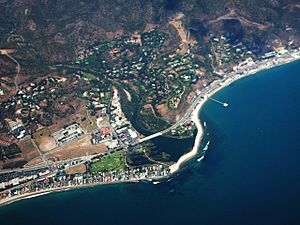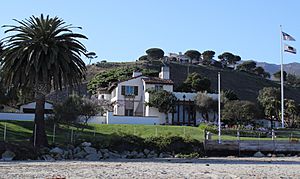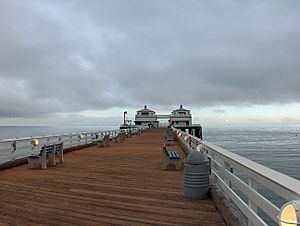Malibu, California facts for kids
Quick facts for kids
Malibu, California
|
|||
|---|---|---|---|

Aerial view of Downtown Malibu and surrounding neighborhoods
|
|||
|
|||
| Nickname(s):
The 'Bu
|
|||

Location of Malibu in Los Angeles County, California
|
|||
| Country | United States | ||
| State | California | ||
| County | Los Angeles | ||
| Incorporated (city) | March 28, 1991 | ||
| Named for | Chumash: Humaliwo, "The Surf Sounds Loudly" | ||
| Government | |||
| • Type | Council–manager | ||
| Area | |||
| • Total | 19.90 sq mi (51.54 km2) | ||
| • Land | 19.86 sq mi (51.45 km2) | ||
| • Water | 0.03 sq mi (0.09 km2) 0.22% | ||
| Elevation | 105 ft (32 m) | ||
| Population
(2020)
|
|||
| • Total | 10,654 | ||
| • Density | 535.38/sq mi (206.713/km2) | ||
| Time zone | UTC−8 (Pacific) | ||
| • Summer (DST) | UTC−7 (PDT) | ||
| ZIP Codes |
90263–90265
|
||
| Area code(s) | 310/424 | ||
| FIPS code | 06-45246 | ||
| GNIS feature IDs | 1668257, 2410913 | ||
Malibu (pronounced MAL-ih-boo) is a famous beach city in Los Angeles County, California. It is about 30 miles (48 km) west of Downtown Los Angeles. Malibu is known for its sunny weather and 21 miles (34 km) of beautiful beaches. Many Hollywood celebrities and important people live here.
Malibu has many expensive homes, but it also has neighborhoods for middle-class families. The main road, the Pacific Coast Highway, runs through the city. Most people live close to this highway and the beach. In 2020, about 10,654 people lived in Malibu. Surfers and locals often call Malibu "The 'Bu."
The city is surrounded by the Santa Monica Mountains to the north. To the east is Topanga, and to the west is Solromar. The Pacific Ocean is to the south.
Contents
- Malibu's Rich History
- Malibu's Geography and Natural Features
- Malibu's Population and People
- Malibu's Economy and Businesses
- Arts, Culture, and Fun in Malibu
- Parks and Recreation in Malibu
- Education in Malibu
- Media and News in Malibu
- City Services and Transportation
- Notable People from Malibu
- Sister Cities
- See also
Malibu's Rich History

Early Inhabitants: The Chumash People
The land where Malibu is today was once home to the Chumash people. They were Native Americans who lived in this area for thousands of years. The Chumash called their main village Humaliwo, which means "the surf sounds loudly." This is where the name Malibu comes from.
Humaliwo was a very important place for the Chumash. It was one of the biggest coastal villages in the Santa Monica Mountains. The village was located near Malibu Lagoon.
Spanish Arrival and Land Grants
In 1542, a Spanish explorer named Juan Rodríguez Cabrillo visited Malibu Lagoon. Later, the Spanish set up missions in California. The Malibu area became part of a large land grant called Rancho Topanga Malibu Sequit in 1802.
In 1891, the ranch was bought by Frederick Hastings Rindge. His wife, Rhoda May Knight Rindge, worked hard to protect their land. She even built her own railroad to stop others from building one through their property. This railroad was called the Hueneme, Malibu and Port Los Angeles Railway.
Building the Pacific Coast Highway
For many years, there were very few roads in Malibu. But in 1929, the state won a court case. This allowed them to build what is now the Pacific Coast Highway. After this, May Rindge had to start selling parts of her land.
The Rindge family's home, known as the Adamson House, is now a state museum. It is located near Malibu Lagoon and Surfrider Beach.
Malibu Potteries: A Unique Art Form
In 1926, May Rindge started a ceramic tile factory called Malibu Potteries. They made beautiful decorative tiles. These tiles can be seen in many buildings in Los Angeles and Beverly Hills. A fire damaged the factory in 1931, and it closed a few years later. Malibu tiles are now very rare and valuable.
The Famous Malibu Colony
The Malibu Colony was one of the first areas where private homes were built in 1926. It became a popular place for Hollywood movie stars to build vacation homes. May Rindge allowed this to help protect her land from being taken by a railroad company.
Today, the Malibu Colony is a gated community with very expensive homes. It offers amazing views of the Pacific Ocean.
Malibu's High-Tech Contributions
Malibu has also been a place for scientific breakthroughs. In 1960, the first working laser was invented here at the Hughes Research Laboratories (now HRL Laboratories LLC).
Becoming a City: Local Control
In 1991, Malibu officially became a city. This allowed local residents to have more control over their area. Before this, they had fought against large building projects planned by the county. They wanted to protect the environment and prevent too much growth.
Residents were especially worried about plans for a large sewer system. They feared it would lead to more development and turn the Pacific Coast Highway into a freeway. After a long fight, the residents were finally allowed to vote and form their own city government.
Malibu's Geography and Natural Features
Malibu is located on the coast, with the Santa Monica Mountains to its north. The city covers about 19.8 square miles (51.3 square kilometers) of land.
Malibu's landscape, with its dry brush and steep hills, makes it prone to natural events. These include fires, floods, and mudslides.
Beautiful Beaches
Malibu is famous for its many beaches. Some popular ones include Big Rock Beach, Broad Beach, County Line Beach, and Zuma Beach. State parks and beaches like Leo Carrillo State Beach and Malibu Creek State Park are also along the coast.
All beaches in California are public below the high tide line. This means everyone can enjoy the sandy shores.
Wildfires in Malibu
Malibu has experienced many wildfires over the years. The dry weather and brush make it easy for fires to start and spread. Some major fires include:
- 1993 Old Topanga/North Malibu Fire: This was one of the largest fires in Malibu's history. It burned over 16,516 acres (6,684 ha) and destroyed many homes.
- 2007 Fires: Several fires occurred in 2007, including one that destroyed homes near the Colony area.
- 2018 Woolsey Fire: This huge fire burned over 96,949 acres (39,234 ha). It destroyed 1,500 buildings and caused many people to evacuate.
After the 1993 fire, Malibu adopted very strict fire safety rules for building homes.
Mudslides: A Natural Challenge
Wildfires can destroy the plants that hold the soil on the hills. When heavy rains follow a fire, this can cause dangerous mudslides. Mudslides happen when water-soaked earth and rocks slide down mountainsides.
For example, after the 1993 wildfire, a massive mudslide closed the Pacific Coast Highway for months. Mudslides can also close other major roads in Malibu during the rainy season.
Coastal Storms and Earthquakes
Malibu also experiences strong coastal storms. In 2008, a rare tornado even hit Malibu's shoreline.
The area is also prone to earthquakes because it is near the San Andreas Fault. Smaller earthquakes happen often, and larger ones, like the 1994 Northridge earthquake, have shaken the area.
Malibu's Climate
Malibu has a warm-summer Mediterranean climate. This means it has warm, dry summers and mild, wet winters. The Pacific Ocean helps keep temperatures moderate. Snow is very rare in Malibu.
| Climate data for Malibu, California (Point Mugu State Park, 1991–2020 normals) | |||||||||||||
|---|---|---|---|---|---|---|---|---|---|---|---|---|---|
| Month | Jan | Feb | Mar | Apr | May | Jun | Jul | Aug | Sep | Oct | Nov | Dec | Year |
| Record high °F (°C) | 88 (31) |
91 (33) |
94 (34) |
100 (38) |
98 (37) |
102 (39) |
101 (38) |
98 (37) |
104 (40) |
103 (39) |
98 (37) |
96 (36) |
104 (40) |
| Mean daily maximum °F (°C) | 66.2 (19.0) |
64.7 (18.2) |
65.5 (18.6) |
66.6 (19.2) |
67.5 (19.7) |
69.9 (21.1) |
72.8 (22.7) |
73.7 (23.2) |
73.1 (22.8) |
73.1 (22.8) |
70.6 (21.4) |
66.0 (18.9) |
69.1 (20.6) |
| Mean daily minimum °F (°C) | 45.6 (7.6) |
45.8 (7.7) |
47.7 (8.7) |
48.3 (9.1) |
51.8 (11.0) |
55.5 (13.1) |
58.4 (14.7) |
58.3 (14.6) |
57.0 (13.9) |
54.2 (12.3) |
48.1 (8.9) |
44.0 (6.7) |
51.2 (10.7) |
| Record low °F (°C) | 26 (−3) |
28 (−2) |
31 (−1) |
31 (−1) |
34 (1) |
37 (3) |
42 (6) |
43 (6) |
40 (4) |
35 (2) |
28 (−2) |
28 (−2) |
26 (−3) |
| Average precipitation inches (mm) | 2.36 (60) |
3.93 (100) |
2.17 (55) |
0.48 (12) |
0.38 (9.7) |
0.11 (2.8) |
0.02 (0.51) |
0.01 (0.25) |
0.08 (2.0) |
0.40 (10) |
0.88 (22) |
1.71 (43) |
12.53 (318) |
| Source 1: Averages: NOAA | |||||||||||||
| Source 2: Records: MSN | |||||||||||||
Malibu's Population and People
| Historical population | |||
|---|---|---|---|
| Census | Pop. | %± | |
| 2000 | 12,575 | — | |
| 2010 | 12,645 | 0.6% | |
| 2020 | 10,654 | −15.7% | |
| U.S. Decennial Census | |||
Who Lives in Malibu?
In 2020, Malibu had a population of 10,654 people. Most residents are White, but there are also people of Asian, African American, and other backgrounds. About 7.8% of the population is Hispanic or Latino.
Malibu is known for its high median household income. This means many families living there earn a lot of money.
Malibu's Economy and Businesses

The Malibu Chamber of Commerce helps local businesses. It was started in 1949 and has over 500 members.
HRL Laboratories, a research company, is the largest employer in Malibu. They are known for inventing the first working laser.
Jakks Pacific, a toy company, is also based in Malibu.
Pepperdine University, a private college, moved to its Malibu campus in 1972. It is a major part of the community.
Environmental groups like the Surfrider Foundation and Heal the Bay are also based here. They work to protect Malibu's beautiful coastline and ocean.
Malibu has several shopping centers, like the Malibu Country Mart. These areas are often visited by tourists hoping to see celebrities.
Arts, Culture, and Fun in Malibu
Art and History Museums
The Getty Villa is an art museum just outside Malibu. It is part of the J. Paul Getty Museum. The museum displays ancient Greek, Roman, and Etruscan art.
The Adamson House is a historic home that is now a state museum. You can learn about the Rindge family, who were the original owners of Malibu.
The Malibu Art Association helps promote art in the community. They organize shows and workshops.
Local Events and Festivals
Malibu hosts several fun events each year:
- Malibu Arts Festival: Held every July, this festival celebrates local art.
- Malibu Chili Cookoff: This event happens every Labor Day weekend. It raises money for children's and youth organizations.
- Malibu Nautica Triathlon: This race takes place every September. It raises money for Children's Hospital Los Angeles.
- Polar Plunge: In February, people jump into the cold ocean at Zuma Beach to raise money for the Special Olympics.
Parks and Recreation in Malibu

Malibu offers many ways to enjoy the outdoors. The hills behind the city have state parkland with trails for horseback riding, hiking, and mountain biking. These trails offer amazing views of the Santa Monica Mountains and the ocean.
The Pacific Coast Highway is also popular for road cycling.
In 2008, the Malibu Pier reopened after major renovations. It's a great place to visit and enjoy the ocean views.
Malibu Bluffs Community Park
The Malibu Bluffs Community Park is a large park with baseball fields and soccer fields. It's home to youth sports organizations like Malibu Little League. The park also has trails and open spaces with beautiful views.
Malibu Legacy Park Project
The Malibu Legacy Park is a special project to restore a 20-acre (8.1 ha) piece of land. It includes a modern water treatment plant. This plant cleans stormwater runoff to protect Malibu Creek, Malibu Lagoon, and Surfrider Beach from pollution. The park also has an outdoor classroom for environmental education.
Surfrider Beach: A Surfing Hotspot
Surfrider Beach is a famous surfing spot. In 2010, it was named the first World Surfing Reserve. It's located near the Malibu Colony and Malibu Pier. This beach was even featured in old surf movies from the 1960s!
Education in Malibu
Schools for All Ages
Malibu is part of the Santa Monica-Malibu Unified School District. It has two elementary schools: John L. Webster Elementary School and Malibu Elementary School.
Malibu High School (MHS) serves students from middle school (grades 6–8) and high school (grades 9–12).
There are also several private schools in Malibu.
Pepperdine University, a private college, is located in central Malibu. Students can also attend Santa Monica College, a community college in nearby Santa Monica.
Malibu Public Library
The Malibu Public Library is a branch of the County of Los Angeles Public Library. It's a large library with areas for adults and children, plus a meeting room. The library opened in 1970.
Media and News in Malibu
Malibu has its own local newspapers, including The Malibu Times and the Malibu Surfside News. Pepperdine University also has a student newspaper called the Graphic.
There are also several magazines focused on Malibu, such as Malibu Arts Journal and Malibu Magazine.
City Services and Transportation
Public Safety
The Los Angeles County Fire Department provides fire protection for Malibu. The Los Angeles County Sheriff's Department (LASD) handles law enforcement for the city.
Water and Mail Services
Water in Malibu is provided by LA Waterworks District 29. The United States Postal Service operates several post offices in Malibu.
Getting Around Malibu
The Pacific Coast Highway (PCH) is the main road through Malibu. It can get very busy, especially in the summer. The LA Metro bus line also runs along PCH.
Notable People from Malibu
Many famous people have lived in Malibu over the years.
Sister Cities
Malibu has one sister city:
 Lijiang, Yunnan, China
Lijiang, Yunnan, China
See also
 In Spanish: Malibú (California) para niños
In Spanish: Malibú (California) para niños















